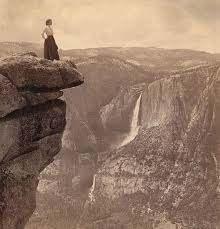Enter now for a chance to win the book
High Country Women: Pioneers of Yosemite National Park
Celebrate the 126th anniversary of Yosemite!

Twenty-four-year-old Lizzie K. Pershing stood at the base of Yosemite’s South Dome staring up at the mountain. A cold, stiff wind traveled across the rock with such force she struggled to keep her balance. She pulled her coat tightly around her shoulders and rubbed her gloved hand over the smooth stone. It was October 8, 1876, and Lizzie was still pondering the climb up the precipice, which was considered at the time to be the largest and highest in the world.1
Standing at the fork of the upper valley South Dome is a solid, rocky loaf six thousand feet above the ground. To Lizzie it appeared as though a powerful hand cut away the eastern half of the mountain, leaving a sheer cliff over a mile in height. According to the July 24, 1860, edition of the Milwaukee, Wisconsin, newspaper The Daily Sentinel, the first person to climb South Dome was a Scottish sailor and blacksmith named George Anderson, and he did so in 1859. George was a skilled outdoorsman who later built a house near the saddle of the dome. During the summer of 1876 he began the difficult task of constructing a staircase of a thousand steps up the dome. He had hoped to have an elevator running by the start of fall in 1876 as well as a steam car that would carry passengers up the almost perpendicular walls. His dream was never realized.2
Since George first tackled the ascent to the top of South Dome, Lizzie and other visitors to the spot had gazed in wonder at the spikes driven into the rock by hardy spirits who had repeatedly endeavored to scale it. The shreds of rope dangling in the wind told the story of their failure. Sheep had been spotted browsing on the hitherto-inaccessible peak. How they got there was a mystery. “They had plenty of grass to eat,” Lizzie contemplated in her memoirs, “but no water, only the dew that fell on the dome at night.”3
Lizzie made the South Dome climb using gear comprised of ropes, harnesses, steal hooks, sturdy boots, and gloves. She carefully studied the method George used to take on the climb. She also read notes written by naturalist John Muir about George’s trek. Prior to George’s climb most Yosemite explorers such as Josiah Whitney insisted the mountain would “never be trod by human foot.”4
“[George] Anderson began with Conway’s old rope,” John, a Yosemite Valley resident who had attempted to climb South Dome but was forced to abandon the effort when it became too hard and dangerous, wrote in his book the Treasures of Yosemite, “which had been left in place, and resolutely drilled his way to the top, inserting eye-bolts five or six feet apart, and fastening his rope fast to each in succession, resting his feet on the last bolt while he drilled a hole for the next above. Occasionally, some irregularity in the curve, or slight foothold, would enable him to climb a few feet without the rope, which he would pass and begin drilling again….”5
To learn more about Elizabeth Pershing and the other women
who helped make Yosemite a National Park read
High Country Women: Pioneers of Yosemite National Park

